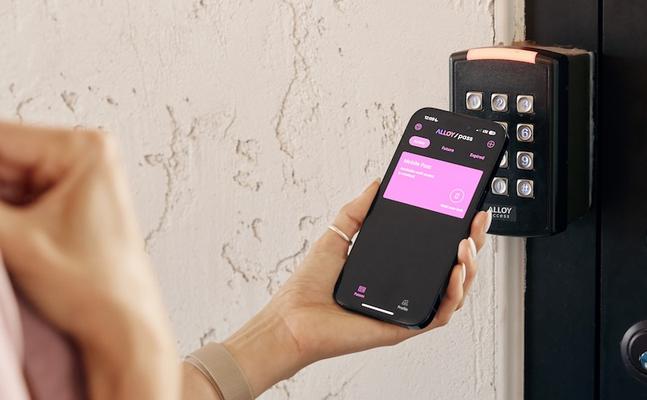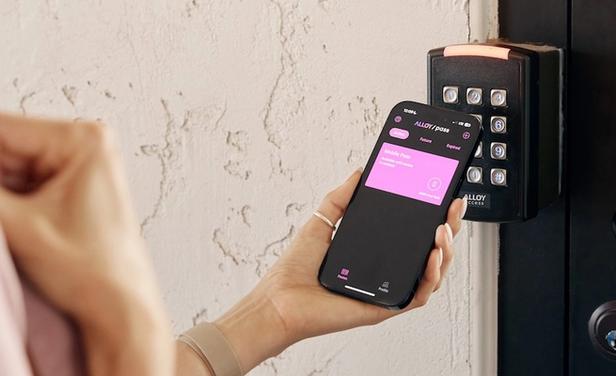Subscribe to our newsletter
You've decided to invest in an access control system for your multifamily community to enhance security and convenience for residents and staff. Naturally, you want the system installed as soon as possible. But before the installation process begins, a certain degree of planning and careful consideration is essential to ensure a successful outcome.
Here, in addition to a guide on what to expect in the installation process, we'll tell you how to prepare for your installation and share a few best practices for selecting your access control installation company. We’ll also give you a refresher on what types of access control systems are available.

Types of access points
If you haven't made a final decision on the type of access control system that best suits your multifamily community, here are some available systems:
Keypads
Although arguably not as high-tech as other access control options, keypads will eliminate one of the most annoying problems multifamily staff encounters—lost keys. Residents enjoy keyless entry to individual units, amenities, common areas, and gates within a multifamily community. Some systems can extend a unique code to property managers and staff for added security.
These access control systems use a numeric keypad into which residents and staff enter memorized PIN codes to access doors and gates.
Keypads are easy to install and offer flexibility in managing access because codes can be easily changed or revoked as needed. However, only the costliest units offer significant customization.
Card readers
Card readers tend to be components of an integrated access control system rather than stand-alone devices. Several card reader systems are available, including proximity, magnetic stripe, barcode/QR code, and smart card readers. These systems are commonly used in multifamily communities and, when integrated with other access control components, can enhance security and convenience for residents.
Locks & lockboxes
Lock boxes are secure metal containers that hold keys or access cards that authorized users can retrieve. Lock boxes are popular in retail and commercial real estate, and allow multiple leasing agents to easily gain entry to vacant homes.
Lock boxes are usually mounted on a door or gate and require a combination or code to open. They provide a secure way for property managers, staff, and prospective residents to enter a community.
Gate-entry systems
Gate-entry systems enhance security by restricting unauthorized individuals' entrance to gated communities, parking lots, or driveways. These systems employ various technologies and typically consist of a gate and an access control device.
Gate-entry systems may include keypad entry, intercom systems, card readers, or handheld remote-control devices. These systems are convenient for residents, who don't have to carry keys to enter their community.
How to prepare for an access control installation
Preparation for your access control system installation is as important as the installation itself. If the appropriate considerations and planning are not established before the system is installed, the final results may not satisfy residents, management, and the community as a whole.
Here are some of those key considerations:
Arrange for power and connectivity: Ensure that all chosen installation locations have the proper electrical outlets and internet connectivity. If you find that additional networking infrastructure is required, coordinate with your IT department or service provider.
Prepare access control credentials: Coordinate with the access control system provider to ensure the credentials are ready for distribution.
Coordinate with residents: Inform residents about the upcoming installation and any temporary disruptions it may cause. Provide them with details such as installation dates, expected duration, and any actions they may need to take (e.g., picking up new key cards).
Provide Access and Assistance: The installation process will flow much smoother if there is clear communication between property managers and the installers. Assign a point of contact from your staff who can assist the installers and answer any questions they may have during the installation process.
Clear installation areas: The installers will need easy access to all installation locations, so make sure all areas are clear of any obstructions. Remove any debris or clutter that may hinder progress.
How to select a professional installation company
After determining what equipment best serves your needs, it’s time to contact a professional installation company. Professional installation is needed to ensure the access control process runs smoothly and your multifamily community's security interests are addressed.
There are many companies that professionally install access control systems. If you choose SmartRent for your install, they’ll assist with the planning process and confirm the successful operation of your new access control system after installation is complete.
Here is some advice to help you find the best installer for your access control system:
Research and recommendations: Begin by checking out local companies. Pay attention to customer reviews and satisfaction ratings. Customer experiences are an excellent guiding light. Also, don't hesitate to ask for recommendations from colleagues, peers, and other property managers who have recently had access control systems installed.
Industry experience: Beyond credentials and certifications comes experience. Does the installer have experience in the access control industry, particularly with the system you chose for your community?
Insurance and licensing: Verify that the installer possesses the proper licensing and adequate insurance required to conduct access control installation in your area. Confirm that they carry liability insurance and workers' compensation.
Request references and testimonials: Request references from past customers who have had access control systems installed by the companies you are considering. Many companies post testimonials and case studies on their websites. If possible, attempt to contact past customers.
Training and long-term support: One of the most essential aspects of vetting an access control installation company is the assurance that they will be available for ongoing maintenance, support, and future upgrades. Select an installer dedicated to the long-term success and security of your multifamily community.
Steps to install access control
After you have prepared for your access control installation and selected an access control professional to install it, it's time to step back and let them proceed.
Professional access control installers typically follow an installation checklist to make sure your new system meets your requirements. Here are the steps you can expect your installation team to take:
Identify the best hardware components for secure access control.
Run the necessary wiring to each component’s location.
Install the hardware components such as readers, keypads, control panels and electric locks.
Configure access control components to the proper system settings.
Integrate the access control system with other security systems.
Train building staff and security for proper use of the system.
The access control system's operation, along with user manuals, documentation, and contact information for technical support, is turned over to the community.

Conclusion
Access control system installation in a multifamily community requires detailed planning, choosing the system best suited for your community, and selecting an installer with expertise in the field. Whatever equipment solution you choose, an access control system can significantly enhance security and convenience for residents and staff.
By following the suggestions offered here, property managers can effectively prepare for the installation process, select a professional access control installation company, and deliver the reliable results that you and your multifamily community expect.

